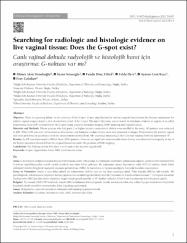Searching for radiologic and histologic evidence on live vaginal tissue: Does the G-spot exist?

View/
Date
2021Author
Sivaslıoğlu, Ahmet AkınKöseoğlu, Sezen
Dinç Elibol, Funda
Dere, Yelda
Keçe, Ayavar Cem
Çalışkan, Eray
Metadata
Show full item recordCitation
Sivaslıoğlu AA, Köseoğlu S, Dinç Elibol F, Dere Y, Keçe AC, Çalışkan E. Searching for radiologic and histologic evidence on live vaginal tissue: Does the G-spot exist? Turk J Obstet Gynecol. 2021 Mar 12;18(1):1-6. doi: 10.4274/tjod.galenos.2021.31697. PMID: 33715320.Abstract
Objective: There is a growing debate on the existence of the G-spot. G-spot amplification by various surgical interventions has become mainstream for esthetic vaginal surgery despite a lack of conclusive proof of the G-spot. The aim of this study was to search for histologic evidence in regions of so-called
hyperintense focus (HF) (considered as the G-spot) using magnetic resonance imaging (MRI) mapping and biopsied tissues.
Materials and Methods: Fifteen patients who had grade 2 or higher anterior compartment defects were enrolled in the study. All patients were subjected to MRI. When a HF was seen, its localization, dimensions, and distances to adjacent structures were measured in images. Dissections in the anterior vaginal wall were performed in accordance with the measurements derived from MRI and tissue measuring 0.5x0.5 cm was biopsied from the determined HF.
Results: An HF was determined in MRI of three (20%) patients. However, no significant neurovascular tissue density was observed histologically in any of the biopsy specimens obtained from the surgical dissections under the guidance of MRI mapping.
Conclusion: Our findings denote that there is no G-spot in the anterior vaginal wall. Amaç: G-noktasının varlığı konusunda büyüyen bir tartışma vardır. Öte yandan, G-noktasının kesin kanıtı olmamasına rağmen, çeşitli cerrahi müdahalelerle G-noktası amplifikasyonları estetik vajinal cerrahide ana akım haline gelmiştir. Bu çalışmanın amacı, hiperintens odak (HF) (G-noktası olarak kabul edilmiştir) denilen bölgelerde manyetik rezonans görüntüleme (MRG) ile haritalama ve biyopsi aracılığıyla histolojik kanıtları araştırmaktır.
Gereç ve Yöntemler: Grade 2 veya daha yüksek ön kompartman defekti olan on beş hasta çalışmaya alındı. Tüm hastalar MRG’ye tabi tutuldu. HF görüldüğünde; lokalizasyonu, boyutları, komşu yapılara olan mesafeleri görüntülerde ölçüldü (“vajinanın ön duvarının haritalanması”). Ön vajinal duvardaki diseksiyonlar MRG’den elde edilen ölçümlere uygun olarak gerçekleştirildi ve HF denilen dokudan 0,5x0,5 cm boyutlarında doku biyopsisi yapıldı.
Bulgular: Üç hastada (%20) HF belirlendi. Ancak MRG haritalaması kılavuzluğunda cerrahi diseksiyonlardan elde edilen biyopsi örneklerinin hiçbirinde histolojik olarak önemli bir nörovasküler doku yoğunluğu gözlenmedi.
Sonuç: Bulgularımız vajen ön duvarda G-noktasının bulunmadığını göstermektedir.

















